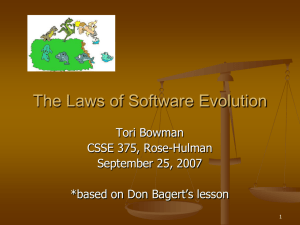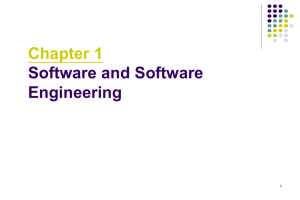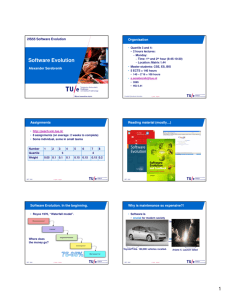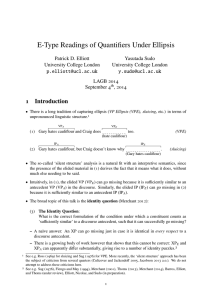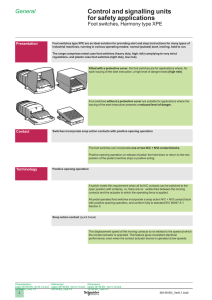E-Type Readings of Quantifiers under Ellipsis
advertisement
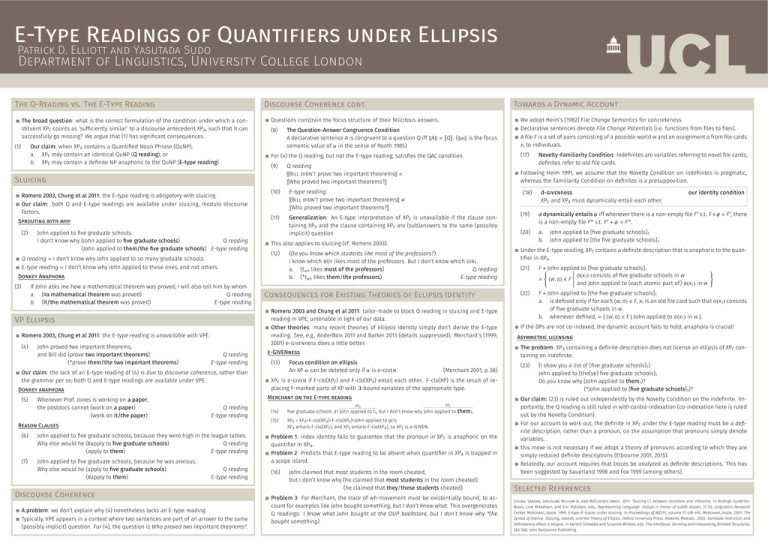
E-Type Readings of Quantifiers under Ellipsis
Patrick D. Elliott and Yasutada Sudo
Department of Linguistics, University College London
The Q-Reading vs. The E-Type Reading
The broad question: what is the correct formulation of the condition under which a constituent XPE counts as ‘sufficiently similar’ to a discourse antecedent XPA, such that it can
successfully go missing? We argue that (1) has significant consequences.
(1)
Our claim: when XPA contains a Quantified Noun Phrase (QuNP),
a. XPE may contain an identical QuNP (Q reading); or
b. XPE may contain a definite NP anaphoric to the QuNP (E-type reading)
Questions constrain the focus structure of their felicitous answers.
We adopt Heim’s (1982) File Change Semantics for concreteness.
(8)
Declarative sentences denote File Change Potentials (i.e. functions from files to files).
Romero 2003, Chung et al 2011: the E-type reading is obligatory with sluicing.
Our claim: both Q and E-type readings are available under sluicing, modulo discourse
factors.
Sprouting with Ђ͚Њ
John applied to five graduate schools.
I don’t know why (John applied to five graduate schools)
Q reading
(John applied to them/the five graduate schools) E-type reading
Q reading ≈ I don’t know why John applied to so many graduate schools.
(9)
(10)
(11)
(12)
Donkey Anaphora
If John asks me how a mathematical theorem was proved, I will also tell him by whom
a. (#a mathematical theorem was proved)
Q reading
b. (it/the mathematical theorem was proved)
E-type reading
Q reading
E-type reading
Our claim: the lack of an E-type reading of (4) is due to discourse coherence, rather than
the grammar per se; both Q and E-type readings are available under VPE.
Donkey anaphora
(5)
Whenever Prof. Jones is working on a paper,
the postdocs cannot (work on a paper)
(work on it/the paper)
(7)
Q reading
E-type reading
John applied to five graduate schools, because they were high in the league tables.
Why else would he (#apply to five graduate schools)
Q reading
(apply to them)
E-type reading
John applied to five graduate schools, because he was anxious,
Why else would he (apply to five graduate schools)
(#apply to them)
E-type reading
Bill didn’t prove two important theorems ,
JWho proved two important theorems?K
(18)
Generalization: An E-type interpretation of XPE is unavailable if the clause containing XPA and the clause containing XPE are (sub)answers to the same (possibly
implicit) question.
(Do you know which students like most of the professors?)
I know which boy likes most of the professors. But I don’t know which girl.
a. (twh likes most of the professors)
Q reading
b. (*twh likes them/the professors)
E-type reading
Consequences for Existing Theories of Ellipsis Identity
e-GIVENness
(13)
Focus condition on ellipsis
An XP α can be deleted only if α is e-given.
(Merchant 2001, p. 38)
XPE is e-given if F-clo(XPE) and F-clo(XPA) entail each other. F-clo(XP) is the result of replacing F-marked parts of XP with ∃-bound variables of the appropriate type.
Merchant on the E-type reading
Reason Clauses
(6)
(17)
Q reading
E-type reading
Discourse Coherence
A problem: we don’t explain why (4) nonetheless lacks an E-type reading.
Typically, VPE appears in a context where two sentences are part of an answer to the same
(possibly implicit) question. For (4), the question is Who proved two important theorems?.
XPA
XPE
(14)
five graduate schools λ1 John applied to t1, but I don’t know why John applied to them1.
(15)
XPE = XPA=F-clo(XPA)=F-clo(XPE)=John applied to g(1).
XPA entails F-clo(XPE), and XPE entails F-clo(XPA), so XPE is e-given.
Problem 1: index identity fails to guarantee that the pronoun in XPE is anaphoric on the
quantifier in XPA.
Problem 2: Predicts that E-type reading to be absent when quantifier in XPA is trapped in
a scope island.
(16)
Novelty-Familiarity Condition: Indefinites are variables referring to novel file cards;
definites refer to old file cards.
Following Heim 1991, we assume that the Novelty Condition on indefinites is pragmatic,
whereas the Familiarity Condition on definites is a presupposition.
Other theories: many recent theories of ellipsis identity simply don’t derive the E-type
reading. See, e.g., AnderBois 2011 and Barker 2013 (details suppressed). Merchant’s (1999,
2001) e-givenness does a little better.
Romero 2003, Chung et al 2011: the E-type reading is unavailable with VPE.
John proved two important theorems,
and Bill did (prove two important theorems)
(*prove them/the two important theorems)
A file F is a set of pairs consisting of a possible world w and an assignment a from file cards
xi to individuals.
John claimed that most students in the room cheated,
but I don’t know why (he claimed that most students in the room cheated)
(he claimed that they/these students cheated)
Problem 3: For Merchant, the trace of wh-movement must be existentially bound, to account for examples like John bought something, but I don’t know what. This overgenerates
Q readings: I know what John bought at the OUP bookstore, but I don’t know why *(he
bought something).
d-givenness
XPE and XPA must dynamically entail each other.
our identity condition
(19)
ϕ dynamically entails ψ iff whenever there is a non-empty file F ′ s.t. F + ϕ = F ′, there
is a non-empty file F ′′ s.t. F ′ + ψ = F ′′.
(20)
a.
b.
John applied to [five graduate schools]1
John applied to [the five graduate schools]1
Under the E-type reading, XPE contains a definite description that is anaphoric to the quantifier in XPA.
(21)
(22)
Romero 2003 and Chung et al 2011: tailor-made to block Q reading in sluicing and E-type
reading in VPE; untenable in light of our data.
VP Ellipsis
(4)
Q reading
Bill didn’t prove two important theorems =
JWho proved two important theorems?K
This also applies to sluicing (cf. Romero 2003).
E-type reading ≈ I don’t know why John applied to these ones, and not others.
(3)
The Question-Answer Congruence Condition
A declarative sentence A is congruent to a question Q iff ∥A∥ = JQK. (∥α∥ is the focus
semantic value of α in the sense of Rooth 1985)
For (4) the Q reading, but not the E-type reading, satisfies the QAC condition.
Sluicing
(2)
Towards a Dynamic Account
Discourse Coherence cont.
F + John applied to [five graduate schools]1
a(x1 ) consists of five graduate schools in w
= ⟨w, a⟩ ∈ F and John applied to (each atomic part of ) a(x1 ) in w
F + John applied to [the five graduate schools]1
a. is defined only if for each ⟨w, a⟩ ∈ F, x1 is an old file card such that a(x1 ) consists
of five graduate schools in w.
{
}
b. whenever defined, = ⟨w, a⟩ ∈ F John applied to a(x1 ) in w .
If the DPs are not co-indexed, the dynamic account fails to hold; anaphora is crucial!
Asymmetric licensing
The problem: XPA containing a definite description does not license an ellipsis of XPE containing an indefinite.
(23)
(I show you a list of [five graduate schools]1)
John applied to [the(se) five graduate schools]1
Do you know why (John applied to them1)?
(*John applied to [five graduate schools]1)?
Our claim: (23) is ruled out independently by the Novelty Condition on the indefinite. Importantly, the Q reading is still ruled in with contra-indexation (co-indexation here is ruled
out by the Novelty Condition).
For our account to work out, the definite in XPE under the E-type reading must be a definite description, rather than a pronoun, on the assumption that pronouns simply denote
variables.
this move is not necessary if we adopt a theory of pronouns according to which they are
simply reduced definite descriptions (Elbourne 2001, 2015).
Relatedly, our account requires that traces be analyzed as definite descriptions. This has
been suggested by Sauerland 1998 and Fox 1999 (among others).
Selected References
Chung, Sandra, Laduslaw, William A., and McCloskey, James. 2011. Sluicing (:) between structure and inference. In Rodrigo GuitérrezBravo, Line Mikkelsen, and Eric Potsdam, eds., Representing Language: Essays in Honor of Judith Aissen, 31-50, Linguistics Research
Center. Merchant, Jason. 1999. E-type A’-traces under sluicing. In Proceedings of WCCFL, volume 17, 478-492. Merchant, Jason. 2001. The
Syntax of Silence: Sluicing, Islands, and the Theory of Ellipsis. Oxford University Press. Romero, Maribel. 2003. Correlate restriction and
definiteness effect in ellipsis. In Kerstin Schwabe and Susanne Winkler, eds. The Interfaces: Deriving and Interpreting Omitted Structures,
263-300, John Benjamins Publishing.



